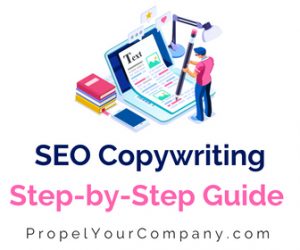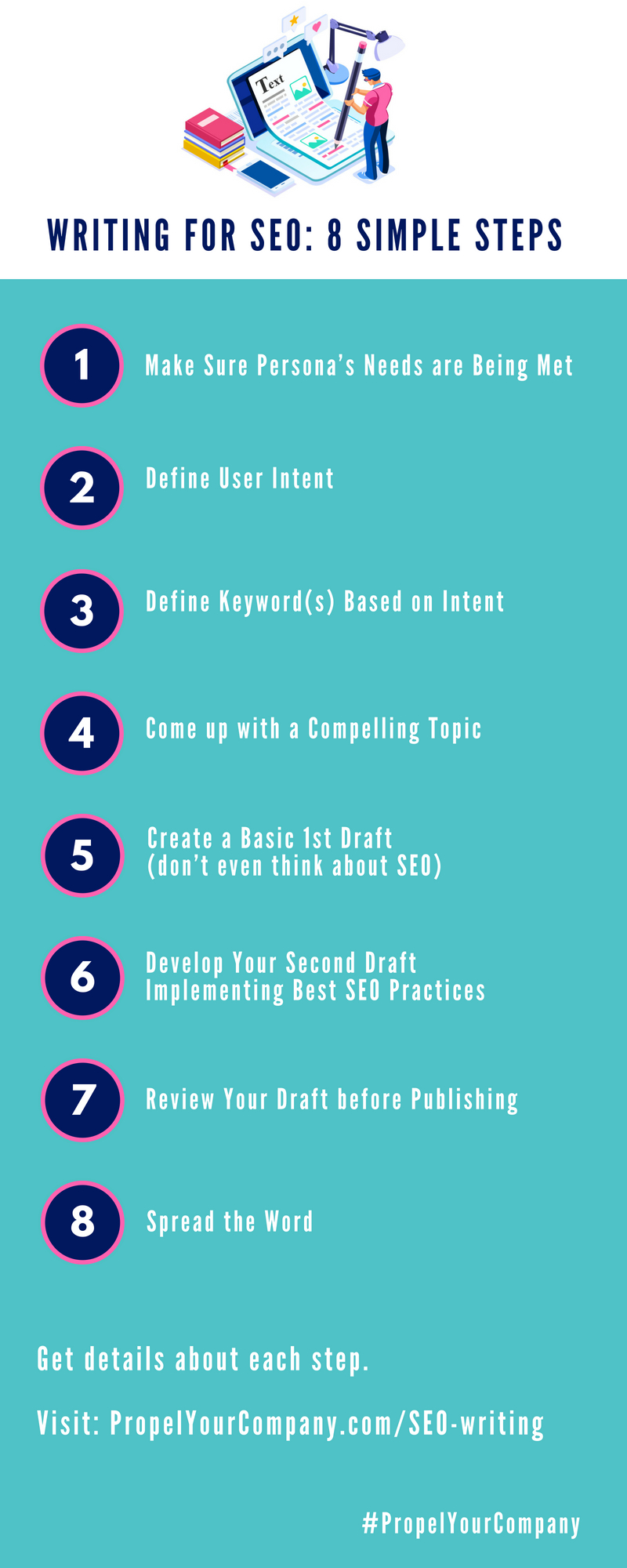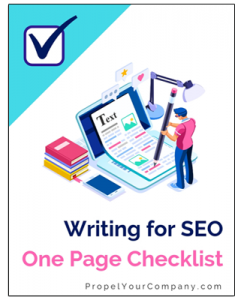Today we’re talking about SEO (search engine optimization) copywriting, otherwise called writing for SEO. Writing for SEO is intentional copywriting designed to get you to the top of the search engines.
And, let’s face it, getting to that coveted top spot on Google is the ultimate goal for any business.
Our 8-step copywriting process is outlined below. It will help maximize your website copy with its strong focus on SEO, leading to more Google attention, more visitors, and more sales.
To help you understand the best SEO copywriting tactics, let’s take a look at the evolution of SEO copywriting.
Bonus: Download a free checklist that will show you how to tap into the important SEO writiting strategies listed here.
The Evolution of “Writing for SEO”
Back in the day, the goal of SEO writing was to make the search engines happy. This could be done using shady tactics that are no longer valuable today and will lead to a scolding from Google if used. Examples include:
- Keyword stuffing
- Cloaking
- Using unreliable, less reputable links for link building
- Repetitive, uncompelling, untrustworthy content
Today, keywords, link building, and strong content are a must, but they need to be done the right way.
Link building, for instance, is extremely important to your SEO campaign, but you must know that not all links are created equal.
The very first paragraph of the “link schemes” section of Google’s Quality Guidelines states:
“ Any links intended to manipulate PageRank or a site’s ranking in Google search results may be considered part of a link scheme and a violation of Google’s Webmaster Guidelines. This includes any behavior that manipulates links to your site or outgoing links from your site.”
Search engines have evolved, and in fact, keep evolving. With new algorithms, they get smarter, and they’ve become great at solving a searcher’s query.
What’s this mean to you? The website that does the best job at solving the searcher’s query wins the ranking game. Those websites that aren’t up to par are left way down in the search results.
If you publish mediocre content that’s correctly optimized for SEO, you may hit a spike in rankings, but as others come along providing better solutions to the searches query, you will get outranked.
Note that writing for SEO is an ongoing task; even evergreen content (content that stays relevant throughout time) often needs to be updated to remain relevant.
To have an online presence, you need to know what Google is expecting of you at all times (watch out for those algorithm updates). We’ve come a long way since keyword stuffing and trying only to appease the search engines. Now to write for SEO, you need to consider:
- User experience (UX)
- High-quality content
- Optimizing for mobile devices
- Social media
- Keywords
- Link building
- Writing for AI (voice search)
- Knowing your audience
- Connecting with your audience
- And more
Don’t think that this is the end of SEO writing goals; if Google has taught us anything, it’s that it loves to shake things up, and updates are always just around the corner!
SEO Copywriting Goals
What is copywriting?
This is the practice of creating copy (text) that educates, informs, inspires, and persuades. Usually, it’s done to help increase sales or get a user to take the desired actions of the writer.
SEO copyrighting boils down to two primary goals.
1. We want to connect with our ideal audience in hopes of them taking a positive action (join your mailing list, subscribe to your blog, share your article on social media, book an appointment online, call you and schedule an appointment, etc.)– this caters to your audience.
And…
2. We want our audience to easily find the content we’ve developed when they’re searching online– this caters to the search engines.
Note the order of the goals: We write for the people first and the search engines second. Customer-focused copy is vital to SEO ranking.
What Makes SEO Optimized Content Different from Traditional Copywriting?
SEO copywriting is specific to writing online to improve your web page rankings while still creating craveable content for your readers.
This is different than traditional copywriting. For example, when writing for print:
- You can have longer paragraphs because someone isn’t trying to read the information on their phone
- Keywords aren’t important to a user finding you
- No link building is necessary
- User experience need not apply
- CTAs? Nope.
You get the idea.
Bonus: Download a free checklist that will show you how to tap into the important SEO writiting strategies listed here.
Now, I think we’re ready to get into those 8 steps, shall we…
Step 1: Make Sure Your Persona’s Needs are Being Met
The first step in content development is determining exactly who the target audience is for a specific page.
The goal of the content should be to educate or entertain this persona. If your goal is to educate, ask yourself:
What problem does the persona have that I can solve in this piece of content?
Take into consideration where they are in the customer journey and make sure you’re meeting their needs with the proper content.
Step 2: Define User Intent
Intent matching matters more than exact keyword matching! Google understands this and knows how to account for non-exact keyword matches.
Remember, at the beginning of the post, we mentioned that the site that provides the most comprehensive solution to the searcher’s query would win the top spot.
You want your one page (or blog post) to focus on that intent alone. Therefore it’s ok to have more than one keyword per page or article as long as they relate to the user’s intent.
Step 3: Define Keyword(s) Based on Intent
So you’ve defined your buyer persona, and you probably have an idea about what the topic is you should write about; now it’s time to define your keywords.
Draft out a list of ideas for keywords. Think like your customers. Focus on niche words.
You can use Keyword Research with tools like:
- Google AdWords Keyword Tool
- Google Trends
- Microsoft Bing Ads Intelligence
- Wordtracker’s Free Basic Keyword Demand
- Moz Keyword Explorer
While it used to be acceptable to choose a few keywords that we wanted our pages to rank for and scatter those words throughout the whole website, that doesn’t work anymore.
These days we think wide.
You can think of the internet as a Monopoly Game board. You remember the game, right? The winner is the one with the most property at the end, covering the board. A good keyword strategy is just like that.
You want to show up for a large number of keyword phrases– RELEVANT keyword phrases. Don’t get so crafty that you’re attracting the wrong audience (anyone who gets to your website or page but doesn’t take the actions you want them to).
You want a user who not only types your keyword phrase into the search bar and then clicks to get on your page but also to stay on that page because you provided them the information they’re looking to find.
Define One Focus Keyword
Jot down which word is your focus keyword (main keyword). You want to think of each page as targeting one mid to long tail keyword. Long tail keywords are more specific and less frequent.
There’s a big difference in the short tail keyword term: Bike tire
And the long tail keyword term: How do I fix a flat bike tire?
And yes, Google knows that when you say a variation of the word for example “bike” you mean the same thing as “bikes,” “bicycle,” and “bicycles.” You don’t have to repeat the same word over and over. You can use variations, and you should.
Note: If you use a tool like Yoast SEO, each page asks you for your focus word. Yoast is a beneficial tool, but it doesn’t always pick up variables as Google does. I often see clients focusing too much on writing around the “focus keyword” and missing the user’s intent and the chance to move up their rankings.
Voice Search is Changing Keyword Research
We’re seeing a rise in length of keywords (more long tail) and the style of the keyword. Searches by voice use more conversational words (also called natural language).
Also, consider location-based search words, if you’re trying to rank for local SEO in specific locations.
Include Commonly Associated Words to Pair with Your Focus Keyword / Keyword Phrase
We want to include words and phrases that Google deems commonly associated with the query.
How do you do this?
Look at web pages that are currently outranking you for the topic/intent of your page.
If you’re drafting a new piece of content, look up the term you’re hoping to rank for and look to see if the current pages holding top spots on the rankings include any associated words or phrases that would make sense for you to highlight in your piece of content.
Step 4: Come up with a Compelling Topic
Now, it’s time to come up with a compelling topic around the keyword and user intent.
Here are some excellent resources to help you come up with your topic:
Step 5: Create a Basic 1st Draft (no need to think about SEO for this draft)
Now, put your notes about keywords away and just start writing.
I suggest starting out by drafting out your blog post without thinking of keyword placement or keyword density. Don’t even worry about SEO until after you’ve written your first draft.
Focus on providing something amazing and unique to the reader.
Remember, we write for the reader first. Then optimize for the search engines to make it more inviting for the reader.
After you have the basic first draft, revisit the list below to see how you can incorporate SEO best practices.
I find that too many people focus on the following best practices and end up writing for Google instead of the buyer persona.
Once you’ve gone through this process for a few blog posts, you’ll start to get the hang of it, and you’ll notice your first drafts need less work to optimize.
Ok, now it’s time to optimize your draft.
Step 6: Create Your Second Draft
Here’s where we start to dive into more SEO best practices for the style of writing.
Again, above all focusing on the reader’s intent.
UX Matters More Than Ever
UX (user experience) matters more now than it ever has before.
Check that you include the following tactics to ensure a good user experience.
The better the user experience, the longer they’ll stay on your site, the more Google will reward you.
Here are some things you should do to ensure a better user experience:
Keep Paragraphs Short
In grade school, you were likely taught that your paragraphs needed to contain four or more sentences. Well, that old-school method does not work when you’re writing for an online reader.
Keep your paragraphs short. In fact, some studies have shown that blogs that use a line break after every sentence perform better.
Make Content Easy to Scan
“We don’t read pages. We scan them.”
-Steve Krug, Don’t Make Me Think
You can do this by adding bulleted lists and headers to identify sections of content.
Use Bucket Brigades
Bucket brigades are phrases or words that add conversational value to your content and attract more and more people to your content.
Ideally, place them in areas of the post where someone would be likely to get bored or might consider leaving the page.
This may not be a strategy that follows the flow of your web pages; if not, use it only in blog posts.
Here are some examples:
- Look:
- Now:
- This is crazy:
- Want to know the best part:
- It gets better (or) worse:
- You may be wondering:
- Here’s the deal:
- Always remember:
- Let me tell you:
- What is the bottom line:
Include Voice Search / Conversation Keywords
As search by voice continues to surge, the instant answer without search results will continue to be on the rise, and Google, Apple, etc. will have to continue to discern simple question/answer problems.
How can small businesses win? Start to include more question and answer specific content for your audience in your blog posts and don’t forget about an FAQ page on your website. You can also add small Q and A sections to individual web pages whenever it makes sense to do so.
Looking for common questions around a keyword: use Answer the Public.
Header tags
Use header tags (H1, H2, H3, H4) that include keywords or variations of the word.
Again, adding these after you’ve created the first draft makes it much easier than trying to tackle it in your first draft.
The reason we do this is for search engines and the searcher. If the searcher types in “how to make coffee” they’ll expect to see a title that has “coffee” in it, not a type of fancy coffee like “mocha.”
Use Your Keyword in the Introduction
Place your keyword in the first 100 words of your blog. Aim to try to get it in the first paragraph. Or, even better: the first sentence.
Write Long Form Content
Ideally, it would be nice for your post to be around 1,000 words. However, quality is way more important than quantity. Google may even penalize you if your content is long but not relevant.
If 1000 words are more than you can handle or unnecessary for any given piece, just be sure you include all the information needed to assist the reader with the one task they’re trying to tackle.
Use Keywords Toward End of Page
Wrap up your post with a conclusion that includes the primary keyword. This bookends the post with signals that define the page.
Keyword Density
You want to use your keyword sprinkled throughout the post, without keyword stuffing.
“The only way to tell if your repetition of keywords is super or spammy is to measure that frequency against the overall length of the content. A keyword density greater than 5.5% could make you guilty of keyword stuffing and your page could be penalized by Google. You don’t need to mindlessly repeat keywords to optimize. In fact, if you do, you’re likely to achieve the opposite result.”
– Brian Clark
Use Anchor Links
Anchor links link to additional relevant content on your website. Aim for 2-3 per blog post.
Include Outbound Links
Use outbound links for reference materials. Make sure these open in a new window, as it keeps the current window open and allows for greater dwell time (the amount of time a user spends on your page).
Outbound links should lead to related content on pages outside of your website. These help Google figure out your page topic and intent.
Use Your Keyword in the Title
Start your title or headline with your keyword or get it as close to the beginning in the title as you can with the title still making sense.
Pro tip: Be sure your headline is catchy and draws the reader in (don’t get so creative they don’t know what it’s about though).
- Use a number if you can
- Be excited- use emotional words that inspire a click (such as: fast, now, new)
- Be specific
Use Power Words
The following power words are proven to increase CTR (click-through-rate). Use words like the following in your title tags and page description tags:
- Best
- News
- Reviews
- Top
- Guide
- Step-by-Step
- Right Now
- Today
- Information
- Community
- Simple
- Quick
- Easy
Use a Grammar & Spellcheck
Write grammatically correct content with no spelling errors. Use a tool like Grammarly.
Great, now you’ve optimized your post, it’s time to upload it.
Step 7: Before You Push Publish Review Your Draft
Ok, so you’ve uploaded your blog post.
Now what? Well, there are a few more things we want to do before you push publish.
Add Images
A picture is worth a thousand words… And, it also breaks up content.
Make sure you add an alt image tag that includes your keyword.
Alt image tags are not only helpful to the reader but also help with rankings in Google Image results. Google Images gets an enormous amount of traffic on its own.
Also, if it’s a blog post, be sure to set your featured image.
Title Tags and Meta Descriptions
We mentioned tags before, but now’s the time to add them if you’re using a tool like Yoast SEO.
For SEO purposes, the meta description should be 150 – 160 characters. We want to include your main focus keyword in the title tag and the meta description.
A person is more likely to click on the URL that contains the term they’re looking for in the title and meta description.
Check Links
Double-check to make sure you’ve given credit to anyone or any website you reference in your content. Then, make sure all inbound and outbound links work properly.
Remember, outbound links should open in a new window.
Now… Push Publish!
Step 8: Spread the Word
Don’t make Google do all the work. Spread the word about your page or post.
If you’ve mentioned any references in your content, reach out to them to let them know and see if they’ll link back to your page. This is one simple way to work on link building.
Also, don’t forget to let social media and your email list know about your new article or page! Give them the link for easy access.
Bonus: Download a free checklist that will show you how to tap into the important SEO writiting strategies listed here.











![How to Write a Professional Chiropractic Bio [Template Included]](https://propelyourcompany.com/wp-content/uploads/write-a-bio-500x383.jpg)

